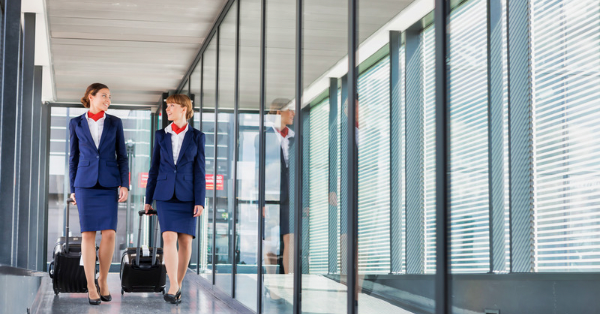High Paying Careers: Flight Attendants
Airlines are required by law to provide flight attendants for the safety and security of passengers. The primary job of flight attendants is to keep passengers safe, ensuring that everyone follows security regulations and that the flight deck is secure. Flight attendants also try to make flights comfortable and stress free for passengers. At times, they may deal with passengers who display disruptive behavior.
Duties
Flight attendants typically do the following:
- Participate in preflight briefings with the pilots, to discuss cabin conditions and flight details
- Conduct preflight inspections of emergency equipment
- Demonstrate the use of safety equipment and emergency equipment
- Ensure that passengers have their seatbelts fastened when required and that all other safety requirements are observed
- Serve and sell beverages, meals, or snacks
- Take care of passengers’ needs, particularly those with special needs
- Reassure passengers during the flight, such as when the aircraft hits turbulence
- Administer and coordinate emergency medical care, as needed
- Provide direction to passengers, including how to evacuate the aircraft in an emergency
Education
A high school diploma is typically required to become a flight attendant. Some airlines may prefer to hire applicants who have taken some college courses.
Those who work on international flights may have to be fluent in a foreign language. Some enroll in flight attendant academies.
Work Experience in a Related Occupation
Flight attendants typically need 1 or 2 years of work experience in a service occupation before getting their first job as a flight attendant. This experience may include customer service positions in restaurants, hotels, or resorts. Experience in sales or in other positions that require close contact with the public and focus on service to customers also may help develop the skills needed to be a successful flight attendant.
Training
Once a flight attendant is hired, airlines provide their initial training, ranging from 3 to 6 weeks. The training usually takes place at the airline’s flight training center and is required for FAA certification.
Trainees learn emergency procedures such as evacuating aircraft, operating emergency equipment, and administering first aid. They also receive specific instruction on flight regulations, company operations, and job duties.
Toward the end of the training, students go on practice flights. They must complete the training to keep a job with the airline. Once they have passed initial training, new flight attendants receive the FAA Certificate of Demonstrated Proficiency and continue to receive additional on the job training as required by their employer.
Licenses, Certifications, and Registrations
All flight attendants must be certified by the FAA. To become certified, flight attendants must complete their employer’s initial training program and pass an exam. Flight attendants are certified for specific types of aircraft and must take new training for each type of aircraft on which they are to work. In addition, attendants receive recurrent training every year to maintain their certification.
Advancement
Career advancement is based on seniority. On international flights, senior attendants frequently oversee the work of other attendants. Senior attendants may be promoted to management positions in which they are responsible for recruiting, instructing, and scheduling.
Important Qualities
Attentiveness. Flight attendants must be aware of any security or safety risks during the flight. They also must be attentive to passengers’ needs in order to ensure a pleasant travel experience.
Communication skills. Flight attendants should speak clearly, listen attentively, and interact effectively with passengers and other crewmembers.
Customer-service skills. Flight attendants should have poise, tact, and resourcefulness to handle stressful situations and address passengers’ needs.
Decisionmaking skills. Flight attendants must be able to act decisively in emergencies.
Physical stamina. Flight attendants push, pull, and carry service items, open and close overhead buns, and stand and walk for long periods.
Pay
The median annual wage for flight attendants was $59,050 in May 2020. The median wage is the wage at which half the workers in an occupation earned more than that amount and half earned less. The lowest 10 percent earned less than $30,930, and the highest 10 percent earned more than $84,790.
Outlook
Employment of flight attendants is projected to grow 30 percent from 2020 to 2030, much faster than the average for all occupations.
About 17,600 openings for flight attendants are projected each year, on average, over the decade. Many of those openings are expected to result from the need to replace workers who transfer to different occupations or exit the labor force, such as to retire.
Source: U.S. Bureau of Labor Statistics



Comments are closed.